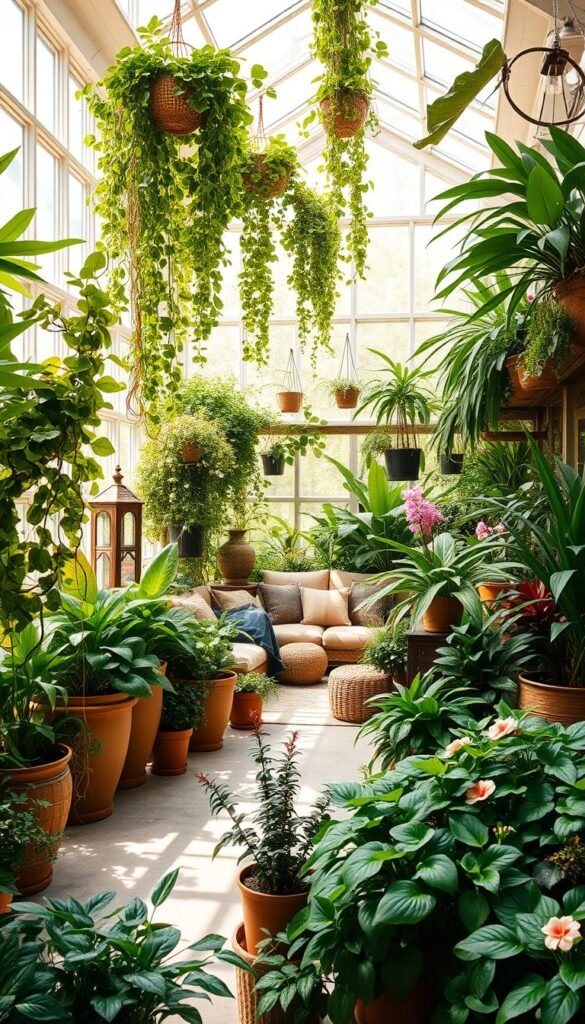Imagine stepping into a space where greenery thrives and fresh air greets you daily. Integrating nature into your living environment isn’t just a design choice—it’s a way to boost well-being and reconnect with the natural world. Urban dwellers and suburban residents alike are embracing this concept, turning corners of their residences into vibrant ecosystems.
Why does this matter? Studies show that surrounding yourself with foliage can lower stress and enhance air quality. Fresh herbs grown in your kitchen or compact vegetable setups in sunlit areas offer practical solutions for sustainable eating. You’ll cut down on grocery trips while enjoying pesticide-free produce.
This movement goes beyond aesthetics. It’s about creating harmony between modern life and ecological responsibility. Whether you’re working with a studio apartment or a spacious loft, adaptable systems let you cultivate plants year-round. You’ll notice how even small additions—like succulents or hanging vines—transform your surroundings.
Ready to start? This guide walks you through designing spaces that nurture both your health and the planet. Discover how simple changes today can lead to a fresher, more balanced tomorrow.
Discover the Benefits of Indoor Gardening
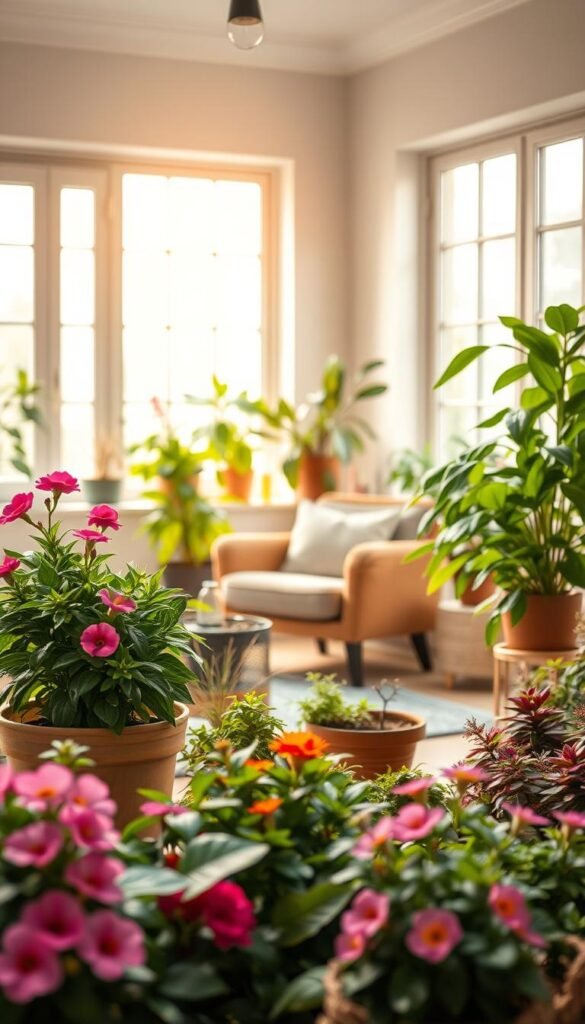
Breathing cleaner air while surrounded by natural beauty isn’t just a dream—it’s within reach. Adding leafy companions to your decor does more than fill empty corners. These living elements quietly work to refresh your environment and elevate daily experiences.
Improve Indoor Air Quality and Atmosphere
Your green allies filter airborne toxins like formaldehyde and benzene while releasing oxygen. This natural exchange creates fresher air, reducing headaches and fatigue. Studies reveal spaces with foliage can lower stress by up to 30%, acting like a calming visual retreat.
During winter months, leafy varieties like peace lilies naturally balance humidity. Their presence in workspaces has been shown to boost concentration by 15%, making them perfect for desks or reading nooks.
Enhance Your Space’s Aesthetic Appeal
From cascading pothos to sculptural snake plants, greenery adds texture and movement to rooms. A well-placed fiddle-leaf fig becomes a living art piece, while vibrant ecosystems in glass terrariums spark conversation. The right arrangements can make ceilings feel higher and spaces more inviting.
Caring for plants becomes a mindful ritual—watering succulents or misting ferns grounds you in the present. This daily touchpoint with nature fosters patience and appreciation for growth, both in your collection and yourself.
Indoor Garden House: Building a Plant-Friendly Lifestyle at Home
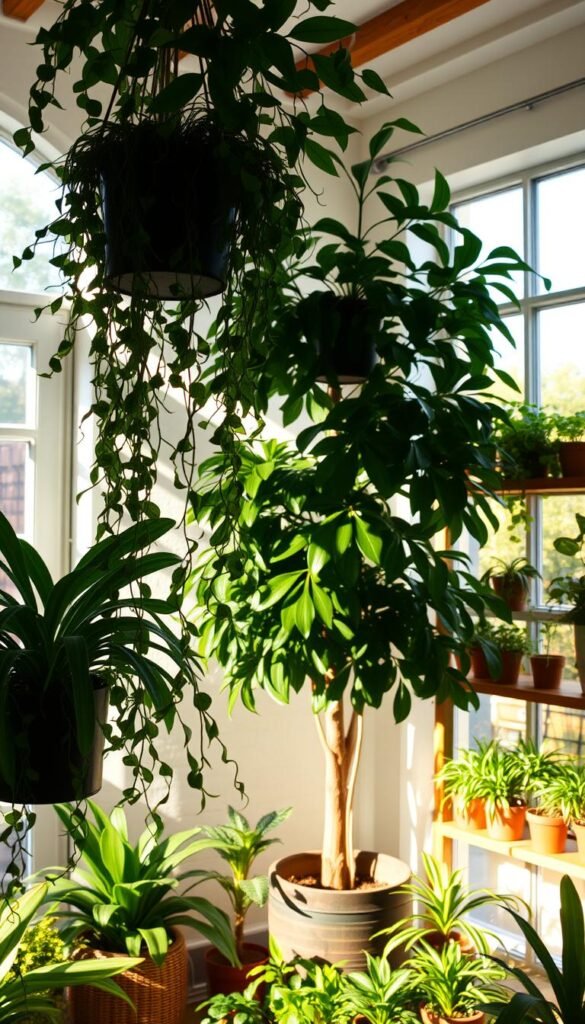
Your residence becomes a green sanctuary when you reimagine walls and surfaces as opportunities for growth. Strategic placement starts with observing light patterns—morning sun in the kitchen? Perfect for basil. Dimmer bedrooms? Ideal for ZZ plants. This intentional approach turns maintenance into mindful moments rather than tasks.
Group moisture-loving varieties like ferns near showers or humidifiers. Place air-purifying species such as spider plants where you relax most. These choices create microclimates that support both plant health and daily comfort. You’ll notice how greenery softens harsh lines in modern interiors while adding organic texture.
Incorporate edibles like mint or cherry tomatoes near cooking areas for fresh flavors at your fingertips. Use vertical planters in tight hallways to maximize every inch. By matching species to room conditions, you build a self-sustaining network that thrives with minimal effort.
Weekly check-ins replace overwhelming chores—rotate pots for even growth, mist tropical leaves, or harvest herbs. These small acts weave nature into your rhythm, fostering pride as your green haven evolves. Soon, you’ll breathe easier knowing your choices nurture both personal well-being and planetary health.
Choosing the Perfect Plants for Your Space
Your green oasis begins with selecting species that match your daily rhythm and room conditions. Focus on resilient varieties that adapt easily, paired with edible options for practical benefits. This balance creates a living space that works with you, not against you.
Thriving With Minimal Effort
Start with forgiving plants like snake plants or ZZ varieties. These champions survive irregular watering and low light. Spider plants add visual interest while filtering air—perfect for shelves or hanging displays.
| Plant Type | Light Needs | Care Level | Key Benefit |
|---|---|---|---|
| Spider Plant | Indirect | Easy | Air purification |
| Snake Plant | Low | Effortless | Overnight oxygen |
| Basil | Bright | Moderate | Culinary use |
| Lettuce | Medium | Simple | Edible greens |
Flavorful and Functional Picks
Grow aromatic herbs like rosemary near sunny windows. Leafy greens thrive in containers—harvest spinach weekly for fresh salads. Mix decorative peace lilies with practical bamboo for style and substance.
Match plants to your schedule. Busy? Try low-maintenance varieties like philodendron. Have time to nurture? Experiment with cherry tomatoes in bright corners. Your space becomes both gallery and pantry when you choose plants intentionally.
Designing Your Indoor Garden Environment
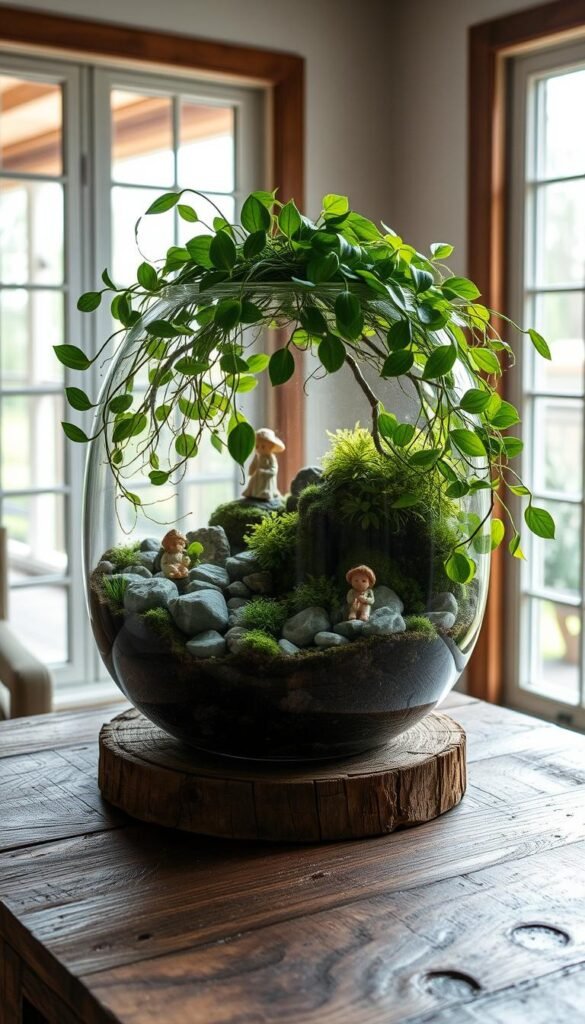
Transforming your living area into a lush retreat starts with smart design choices. Containers become functional art when selected thoughtfully, blending practicality with visual storytelling. Let’s explore how to create spaces where greenery thrives and inspires.
Terrariums, Pots, and Custom Planters
Terrariums offer captivating self-contained ecosystems. Layer sand, stones, and soil in glass enclosures to craft humidity havens for ferns or mosses. These low-maintenance displays bring nature’s complexity into compact formats.
| Container Type | Material | Best For | Maintenance |
|---|---|---|---|
| Terrarium | Glass | Moisture-loving plants | Monthly care |
| Coconut Coir | Biodegradable | Seedlings & herbs | Water daily |
| Ceramic | Glazed clay | Statement pieces | Weekly checks |
| Wall Planter | Recycled plastic | Vertical displays | Biweekly attention |
Swap plastic pots for coconut coir alternatives—they decompose naturally while supporting root health. Mix geometric ceramic planters with rustic wood boxes for textured displays that spark joy.
Designing for Small Spaces and Personal Style
Maximize tight corners with hanging terrariums or stackable pots. Try these space-smart solutions:
- Magnetic herb gardens on fridge doors
- Foldable shelves with cascading pothos
- Window ledge succulent arrangements
Your containers should mirror your personality. Repurpose vintage teacups for air plants or paint terra-cotta pots in bold patterns. Proper drainage matters most—drill holes in unconventional containers before planting.
“The best displays balance form and function, letting plants shine while solving spatial challenges.”
Maximizing Light: Natural and LED Solutions

Light fuels growth in your green spaces, whether streaming through glass or emitted by modern tech. Understanding your environment’s natural rhythms helps you work with available resources while filling gaps creatively.
Placing Your Garden Near Windows and Sunny Spots
Track sunlight patterns across rooms for 2-3 days. South-facing windows offer the most consistent rays—ideal for herbs like rosemary or peppers. East-facing spots provide gentle morning light perfect for leafy greens.
Rotate pots weekly to prevent lopsided growth. In winter, move light-hungry varieties closer to glass. Use sheer curtains to diffuse intense afternoon beams that might scorch delicate leaves.
Integrating Energy-Efficient Grow Lights
Full-spectrum LED panels mimic sunlight, letting plants thrive in dim corners. Position them 6-12 inches above foliage, adjusting as stems stretch. Timers automate daily cycles—14 hours for veggies, 8-10 for succulents.
| Window Direction | Light Intensity | Best For |
|---|---|---|
| South | Bright, all-day | Flowering plants |
| North | Low, indirect | Ferns, mosses |
| East | Soft morning | Herbs, lettuce |
| West | Strong afternoon | Cacti, tomatoes |
Combine natural and artificial sources for layered solutions. A sunlit window sill paired with under-cabinet LEDs creates a 24-hour growing zone. Choose fixtures with adjustable brightness to match seasonal changes.
Innovative Indoor Gardening Techniques for Urban Living
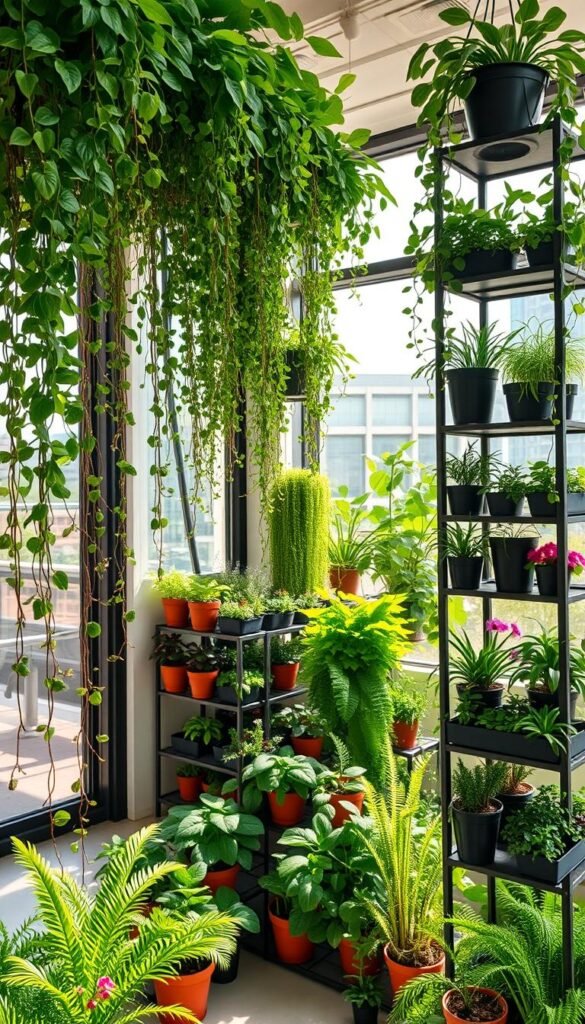
Urban living demands creativity when cultivating greenery. Vertical solutions turn unused walls into thriving ecosystems while saving precious floor area. These methods blend practicality with visual impact, letting you grow more without compromising style.
Elevating Growth With Smart Displays
Wall-mounted shelves transform blank surfaces into lush cascades. Pair trailing pothos with spider plants in hanging baskets—their tendrils create natural curtains that purify air. Use tension rods between walls for instant vertical gardening zones.
Multi-tiered systems accommodate diverse needs. Top levels host sun-loving herbs, while shade-tolerant ferns occupy lower tiers. Repurpose old ladders as plant stands or mount pallets for rustic charm. Each structure becomes a conversation piece.
| Vertical Structure | Best Plants | Space Saved |
|---|---|---|
| Hanging Baskets | Philodendron | 100% floor area |
| Wall Grids | Air plants | 2-3 sq ft |
| Tiered Stands | Succulents | 1.5 sq ft |
Self-watering planters reduce maintenance in hard-to-reach spots. Rotate displays weekly so all sides receive light. A simple drip tray under wall planters prevents water damage.
Mix textures for depth—velvety coleus beside spiky snake plants. Your vertical spaces become living art that thrives with minimal care. Start small, then expand as your confidence grows.
Exploring Soil-Based and Hydroponic Methods
Cultivating greenery offers two distinct paths—each with unique advantages. Traditional soil methods connect you with earth’s natural rhythms, while hydroponic systems unlock space-efficient solutions. Let’s examine how both approaches can coexist in modern spaces.
Soil Quality, Organic Fertilizers, and Nutrient-Rich Solutions
Start with high-quality potting mixes containing perlite or coconut coir. These materials improve drainage while retaining essential nutrients. Organic compost acts as slow-release fertilizer, feeding roots gradually.
| Method | Key Components | Best For | Maintenance |
|---|---|---|---|
| Soil-Based | Organic compost, vermiculite | Flowering plants | Weekly watering |
| Hydroponic | Rockwool, nutrient solution | Leafy greens | pH monitoring |
Test your soil every 3 months using simple kits. Adjust pH levels with lime or sulfur to help plants thrive. Mix in worm castings for extra microbial activity.
Hydroponic Systems for Space Efficiency
Try affordable DIY hydroponic projects using plastic containers and air pumps. Wick systems work well for beginners—basil grows 30% faster than in soil.
Deep water culture setups let roots soak in oxygen-rich solutions. Perfect for growing crisp lettuce and spinach. You’ll harvest fresh vegetables every 2 weeks with proper nutrient balancing.
Monitor electrical conductivity (EC) levels in hydroponic tanks. Leafy greens prefer 1.2-2.4 EC, while fruiting plants need 2.4-3.6. Adjust formulas as your crops mature.
Watering, Fertilizing, and Natural Pest Control
Nurturing your green space becomes effortless when you align care routines with nature’s rhythms. Simple adjustments in how you hydrate, feed, and protect your leafy companions can yield healthier growth while reducing waste. Let’s explore sustainable strategies that keep your ecosystem thriving.
Smart Water Practices and Reusing Resources
Collect water from unexpected sources to conserve resources. Save cooled pasta water or dehumidifier runoff for thirsty plants. Even shower warm-up drops can hydrate ferns—just make sure it’s free of harsh soaps.
Check soil moisture before watering—dry knuckle-depth means it’s time. Group plants with similar hydration needs to streamline care. Overwatering causes more harm than underwatering, so observe leaves for drooping cues.
Natural Alternatives to Chemical Pesticides
Combat pest issues without toxins. Neem oil disrupts insect life cycles when sprayed weekly. Sprinkle cinnamon on soil to deter fungus gnats—its antifungal properties protect roots naturally.
Crushed eggshells add calcium while sharp edges deter slugs. For aphids, mix dish soap with water and spray affected leaves. Always isolate infected plants to prevent spreading.
Turn kitchen scraps into fertilizer instead of buying synthetic options. Banana peels buried near roses boost blooms, while coffee grounds acidify soil for blueberries. Make sure to compost these first to avoid mold.
By adopting these methods, you create a safer environment for both plants and people. Your green haven flourishes when care aligns with Earth’s wisdom.

